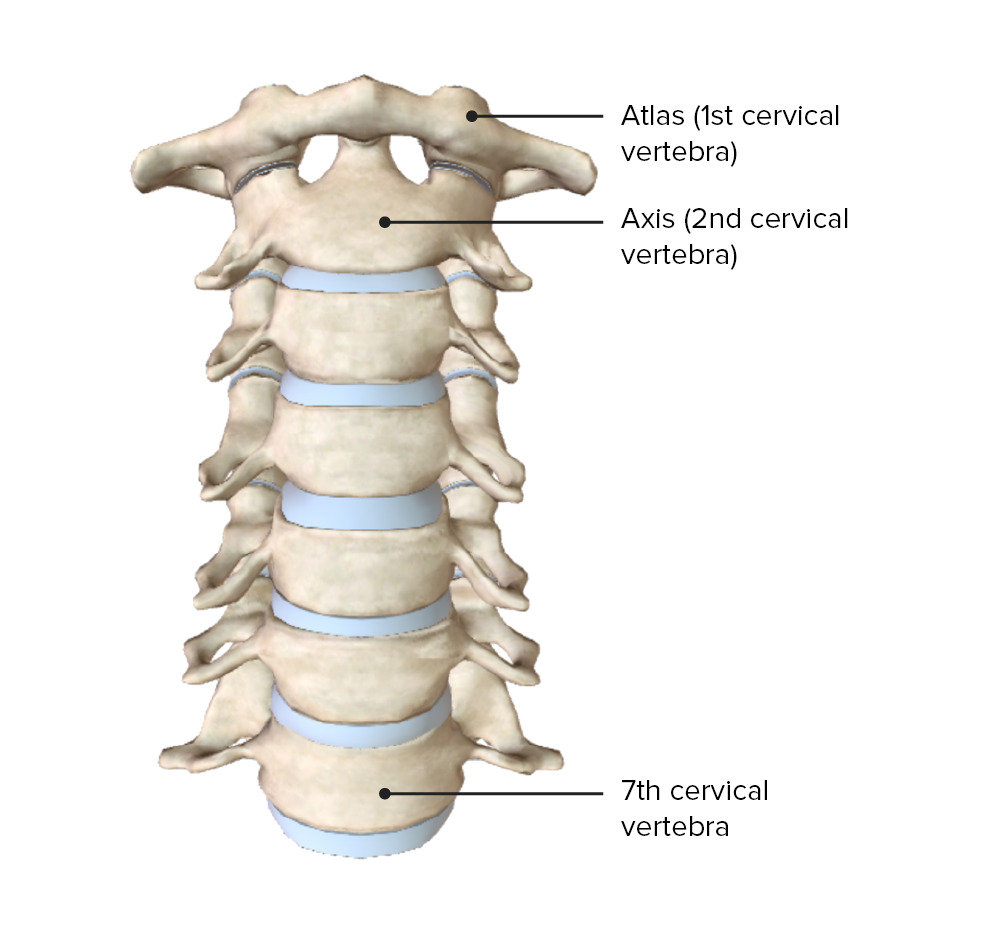Playlist
Show Playlist
Hide Playlist
Thoracic Spine: Introduction
-
Slides Osteopathic Diagnosis of the Thoracic Spine Region.pdf
-
Reference List Osteopathic Manipulative Medicine.pdf
-
Download Lecture Overview
00:01 So we're gonna talk a little bit about the thoracic spine There's some general characteristics of the spine that you could appreciate. 00:07 The thoracic spine is primarily a kyphotic curve which means that it is convex posteriorly. 00:12 This convexity is present from birth. It is relatively immobile. 00:16 It's not really mobile because it is connected to a rib cage and the rib cage limits the ability for motion and movement in the region. 00:24 It is a transition zone between the cervical and thoracic regions and it helps to form the posterior portion of the thorax. 00:31 We could divide the thoracic spine into functional divisions. 00:34 From T1 to T3, this is the cervical thoracic junction. 00:38 It is slightly lordotic. 00:40 Whereas from T4 to T9, this is where we consider the true thoracics and this is more kyphotic. 00:47 And then from T10 to T12, it's a little bit more backward bending this is where the thoracic spine starts to transition to the lumbar spine. 00:55 You could usually find an apex around T5 to T6. 00:59 So the rule of threes helps us to have a better understanding of the relationship between the spinous process and the transverse processes. 01:07 This is important because in much of what we do with osteopathic diagnosis, we are going to be utilizing the transverse processes to identify for somatic dysfunction. 01:16 Remember, for somatic dysfunction, we're looking for tissue texture changes TART changes which stands for Tissue texture changes, Asymmetry, Restriction of motion and Tenderness. 01:26 And so if you find these somatic dysfunctions, you're gonna be looking for them along the transverse process. 01:31 Once we find a somatic dysfunction along the transverse process, it's important to understand the relationship between the transverse process and the spinous process so we know anatomically where our level is. 01:42 And so there are certain key landmarks to find along the spine where the spinous process helps us identify which level of the spine we're located. 01:51 So, if you think about the T1 level, it's right below C7 which is vertebra prominens which is easier to find if you have someone flex your head forward. 02:00 If you look at the scapula and at the spine of the scapula if you come directly at the same level of the spinous scapula, that would get you to T3. 02:09 If you are at the inferior border of the scapula, that would get you to T7. 02:13 And if you find the 12th rib and track yourself medially to the spinous process, that would be a T12. 02:18 So it's easy to identify these landmarks for the spine midline but when we diagnose for somatic dysfunction, we're pushing on the transverse process. 02:28 So most of the time we need to find the transverse process level by first identifying the dysfunction and then going backwards and seeing where the spinous process is. 02:38 And this takes us to the rules of three. 02:40 So the rules of three helps us to find where we're located in the spine based on the spinous process and transverse process relationship. 02:50 So the rules of three, you're looking at 3 thoracic vertebrae at a time. 02:55 And so, from T1 to T3, you will find the spinous process pretty much at the same level as the transverse process. 03:02 From T4 to T6, now the spinous process start to shingle down a little bit more inferiorly and you'll find the spinous process is halfway between the transverse process of that level on the one below it. 03:14 From T7, 8 and 9, here the spinous processes are at the level of the transverse process below it. 03:20 So it's moving a lot more inferiorly and so for instance, if I am looking for the spinous process of T7, I'm going to find that at the level of the body of T8. 03:32 T10 functions like T7 to 9, so the spinous process is going to be found at the level below at T11. 03:40 T11 is more like T4 to T6 so this spinous process will be found halfway below between 11 and 12. 03:47 and T12 now is gonna be at the same level similar to T1 to T3. 03:54 So now let's take a look at how you would utilize this in clinical practice. 03:58 So if you have a patient and you found tenderness at the right transverse process in the back and you note that's at the level of the thoracic spinous process that's in line with the inferior boarder of the scapula, What is the level of the the transverse process you palpated? So here we have to work backwards. 04:19 First we have to identify the spinous process level. 04:22 So like we said before, the inferior border of the scapula is gonna be in line with the spinous process of T7. 04:28 So if you have the spinous process of T7, what is the transverse process at that same level? And so going back to rules of three, you know that because the spinous process is going to be 1 full level below, you know that that's going to be the transverse process of T8.
About the Lecture
The lecture Thoracic Spine: Introduction by Sheldon C. Yao, DO is from the course Osteopathic Diagnosis of the Thoracic Spine Region.
Included Quiz Questions
As the beginning of the kyphotic curve, which of the following thoracic vertebra marks the beginning of the true thoracic vertebrae?
- T4
- T3
- T5
- T1
- T2
What is the bony landmark used as the initial step in diagnosing somatic dysfunction in the thoracic spine?
- Transverse process
- Spinous process
- Superior articular process
- Inferior articular process
- Lamina
When palpating, which of the following vertebral levels is the location of the spinous process of T10?
- At T11
- At T9
- At T10
- Between T9 and T10
- Between T10 and T11
Customer reviews
5,0 of 5 stars
| 5 Stars |
|
1 |
| 4 Stars |
|
0 |
| 3 Stars |
|
0 |
| 2 Stars |
|
0 |
| 1 Star |
|
0 |
Very concise and high yield! The images as you explain helps.




